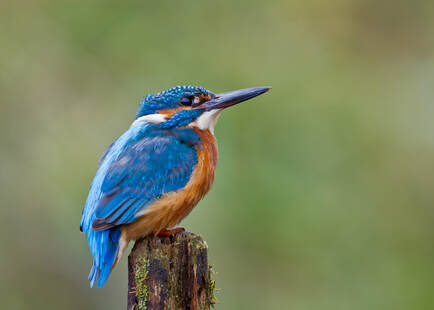 Image by Simon Phillpott. My attempts are just a blurry flash of colour.
Image by Simon Phillpott. My attempts are just a blurry flash of colour. Catching even a glimpse of their incredibly bright plumage is an up-lifting treat: it feels like such a thrill should somehow be on a prescription for anyone feeling a bit gloomy and pessimistic about life.
I've already written about the benefits of our house being flooded - one of them is that the morning after a greedy kingfisher always makes an appearance, tucking into the glut of small fish in the mill pond.
We're lucky enough to see it quite regularly: he seems to have spates of showing up a few days running at almost exactly 11.00 am, then disappearing and changing its regular appearance just to make sure we're being observant. Every time when we see it, we feel the need to point out to anyone around 'ooh, there's the kingfisher!' If it's on a work day I'm often on the phone, so client conversations are punctuated with these words - irrelevant to them, but meaning I'm slightly distracted as I watch. I'm sure some think I'm fibbing because it's such an unreal sight.
I haven't yet discovered where its nest is but it's presumably quite near by. They create a nest burrow in sandy soil on a vertical bank without any vegetation, making a tunnel where the eggs are laid. A while ago, dedicated wildlife artist Robert E. Fuller investigated and filmed kingfishers as they nested.
Kingfishers are flashy, their colours impossibly glamorous on a dull Dales day. If humans dressed so well in the Dales, everyone would ask where they were going. I love their lush colours but also admire their equality.
Unlike some bird species where the female looks dowdy and ground down by the daily effort of being a female, male and female kingfishers are almost identical except for their beak - the female looks a little like she's wearing lipstick. The male and female create the burrow together, and it's used two or three times in quick succession - once you've seen the work involved, you'll understand why they make full use of it! And they both share in incubating the birds. The chicks have lovely manners in the nest: they're fed in rotation and then go to the back of the nest to digest their fish, letting the other chicks move to the front of the queue.
They're not quite so pleasant once they fledge. After kingfishers have swooped into the water for fish they perch somewhere hard and repeatedly strike the fish. Sometimes I've watched them and been quite sure the fish was dead but they always seem to give it an extra strike for good measure. They prefer to eat small fish such as sticklebacks (doesn't the very name conjure up childhood memories?) and minnows but will also help themselves to 'my' frogspawn too. Speaking of which, I've normally found some by now but not sighted it in the mill pond yet.

 RSS Feed
RSS Feed
